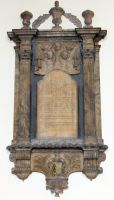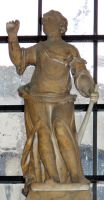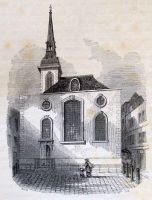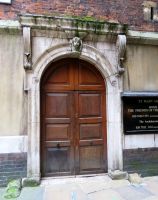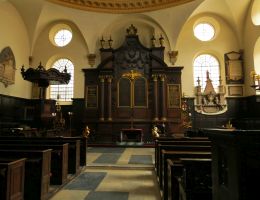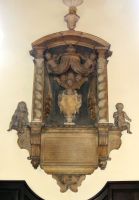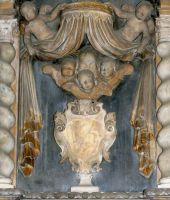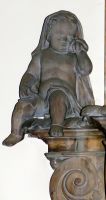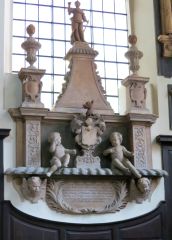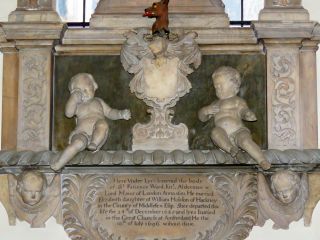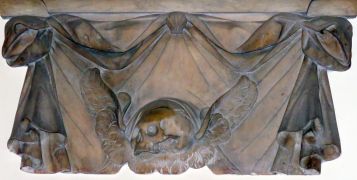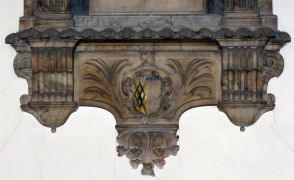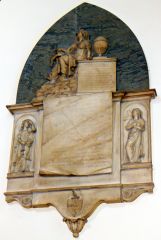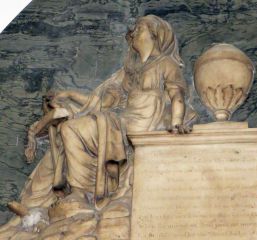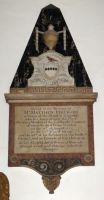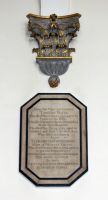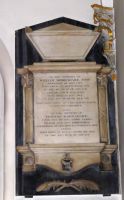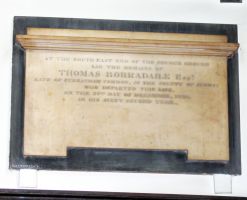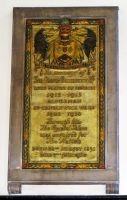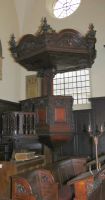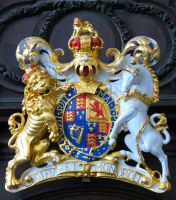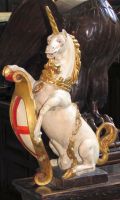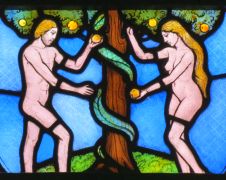St Mary Abchurch - Monuments
St Mary Abchurch, considered one of Christopher Wren's finest surviving City Churches, features a complete interior including a domed ceiling painting by James Thornhill, and several monuments from the late 17th Century onwards. It is just north of Cannon Street, in Abchurch Lane.
The Church:
Sir Christopher Wren rebuilt St Mary Abchurch in 1681-86 to be almost square, 63 ft by 60 ft, the height being somewhat lower at 51 ft, and the steeple 140 ft high. His building replaced an early medieval one, lost with all monuments (see end of page) in the 1666 Fire.
From the outside, the view from a distance immediately shows a level of symmetry, a squarish exterior wall, and the main features being numerous round porthole windows, and the short tower curvily joining to a thin, square in cross section spire. Close to, the individual walls are rather flat, brick, with rather plain stone dressings to the round-headed windows, with, however, small cherub heads at the keystone positions, and two grotesques (see picture below - you will need to click to enlarge). Wren's mason for this City Church was Christopher Kempster, so we can presume that these ornaments are his works - we will see a bit more of his work inside.
St Mary Abchurch: exterior and interior views.
The inside is a contrast: the round ceiling, elegant curves and arches supporting it, and a single free standing pillar, quite thin, masses of dark pewing below and the dark painted ceiling above, with the white walls in between, enlivened by decorative woodwork and our monuments.
The monuments include around a dozen worth noting for their ornament, including two late 17th Century ones and half a dozen spanning the 18th Century.
Monuments
Edward Sherwood, d.1690, offspring John Sherwood, d.1703, Richard Sherwood, d.1703/4, and Elizabeth Lordell, and two children of John Sherwood. The bulky monument has a central cartouche of arms, with four winged cherub heads hovering above it. Above, a canopy, held up and hanging to the sides by two further cherubs, half-figures this time. To each side is a twisted column with Corinthian capital, supporting an open, curved pediment. At the top, an urn; to the outside of the pillars are a pair of seated putti, one of which wears a cowl and is dabbing at its eye with a clutched handful of drapery. They rest upon a gadrooned (corrugated) shelf supported under the pillars by two curly brackets with moulding. Between those is the panel with the inscription, and beneath, two further winged cherub heads. A good piece of its time, albeit with somewhat of a surfeit of cherubs - if you like such things, lots more winged cherub heads on this page. The monument has been attributed to the sculptor William Woodman the Elder.
Sir Patience Ward, d.1696.
Sir Patience Ward, Knight, d.1696, Lord Mayor in 1681, and his wife Elizabeth [Hobson] Knight, d.1685. An unusually shaped monument, with the composition focused on the shield of arms of Sir Patience, which is centremost, flanked by a pair of plump, gesticulating putti (see pictures above, click to enlarge). Behind, a black backing, with square pilasters to the sides, bearing low relief scrolly leaf carving, an upper and lower shelf, the lower of which is gadrooned. On top, a central, tall plinth, with slanted sides adorned with carved flowers, and gadrooned top. supports a standing female figure, one hand raised, the other holding some object - she has been suggested as either Hope or Patience (picture at top of page, far right). Above the pilasters to the sides are a pair of flaming urns, narrow stemmed, and supported on raised plinths each with a cartouche of arms. At the base under the lower shelf, on the portion of the monument called the apron, the inscription is surrounded with two finely-carved palm leaves, and to the sides are two winged cherub heads acting as supports for the pilasters above. All rather grand, and made the more impressive by being mounted with the upper portion in front of a window for dramatic effect. The piece has been suggested as the work of the sculptor Thomas Cartwright the Elder.
Winged skull from Tournay monument.
Jane Tournay, d.1718, and husband Anthony Tournay, d.1726. The inscribed panel, difficult to read, has curly sidepieces with low relief carving, and an upper shelf with a curved pediment broken at the top to admit a cartouche of arms. Below, the familiar gadrooned shelf, and below that, an interesting composition of a nicely carved drape, held at centre and generous knots at the corners, with a winged skull in front as a memento mori (hover over picture for more information).
Sanders Oliver carving from Eaton monument.
Benjamin Eaton, d.1730, his wife Elizabeth Eaton, d.1741, and eight of their children who all died young, erected by the only surviving son. The inscription, on an arched panel against a black backing, has above it a composition of three winged cherub heads among lightly carved clouds with sunbeams, under a canopy formed by a drapery, held up by the uppermost head and two sea-shells. To the sides, two tall, fluted Corinthan pilasters (flat pillars), supporting a shelf on which stand three pots or funereal urns, the central one slightly larger and with festoons of carved flowers on each side, and no surviving backing. At the base, a heavy dragooned (corrugated) shelf, supported on large curly brackets, and in between the painted cartouche of arms, with low relief carved branches to each side, and acanthus leaf terminus below. The whole in white marble, aged to a beige tint, with dramatic dark streaking, and representative of a class of monochromatic monumental panels on large scale which were popular at this time. The sculptor was Sanders Oliver - detail above, and full picture at top of page.
Martha Perchard, d.1787.
Martha Perchard, d. 1787, and four young children. The inscription, really difficult to read, is carved on a parchment with creases across it, an unusual variant on the unrolling scroll or hanging cloth style. To left and right are standing female figures carved in high relief within niches, and above, a third Classical girl is seated on some rocks, resting against a plinth, itself bearing lengthy prose regarding Judgement Day, supporting a small funereal urn. This upper part has a grey backing curved upwards to a point. At the base, a short apron bearing a shield of arms, scrolling carved in relief to the sides, and a terminus of acanthus leaves. The three figures are good - each with a cowl, long Classical robes, figure hugging and with harmonious folds, each with a cowl, their hands particularly well delineated. They have been suggested as Faith, Hope and Charity, but while one standing figure has a cross (Faith), the other, with one hand to her head and looking downwards (picture at top of page, far left), is hard to identify with either Hope or Charity, and the seated figure has an anchor between her knees, usually a sign of constancy, or as here, with the torn rope, as if the anchor of the husband's life has been lost. Regardless, the work of an accomplished sculptor.
Matthew Perchard, d.1777, Prime Warden of the Goldsmiths Company, and a native of Guernsey. An obelisk monument in coloured marbles. The inscribed panel, on a pale, faintly streaked marble, is surrounded by a border of red and cream stone. Above is a shelf with mouldings on which rests the obelisk, a good half the height of the whole monument, in black marble with arresting inclusions and streaks. In front of this, the Perchard arms are carved in relief on a white marble block with upper curved shelf, supporting a funereal urn with hanging chains of flowers to the sides. At the base, a narrow curvy apron in dark marble with lightly carved curly foliage in front; at the base, a terminus with carved acanthus leaves. The whole gives a feeling of lightness and delicacy for what is a heavy monument. Apparently by Sanders Oliver again. Lots more information on obelisk monuments on this page.
Matthew Perchard, and Yeats.
Timothy Yeats, d.1792, his wife Frances Yeates, d.1770, their daughter Mary Yeats, d.1764, two infant sons Thomas and Timothy, and Frances Yeates' sister Elizabeth Stephenson, d.1774, erected by Elizabeth Temple. Tea-tray or stretched-octagon shaped panel with double border of black marble and no other ornament.
Elizabeth Fenwick, d.1793, the inscription on a square with carved sunbursts to each side, on a roundel of greyish marble.
Thomas Borradaile, d.1828, of Streatham Common, then in Surrey. Cut as a tomb chest end, with feet and upper shelf, on a black backing signed by the statuary, Bainbridge, and one of three pieces by him in the Church.
Bainbridge's tablets to the Borradaile family.
William Borradaile, d.1831, 'Merchant of this City', his wife Ann Borradaile, d.1812, and their fifth son, Thomas Borradaile, d.1822, Commander of the Hon. East India Company's ship Inglis. Tall white-on-black monument. The inscription has the usual upper and lower shelves, but the sides of the frame are carved not as pillars, but axes surrounded with sticks, bound together. On top, a casket tomb, thus a boxy affair with outward slanting sides, pointed lid and acroteria. At the base, a wavy apron incorporating the painted shield of arms, the sides receding and bearing carved flowers, and below all that, crossed frondy branches. On a black backing.
Archibald McNair, d.1826, and his wife Mary Ann McNair, d.1832. Cut as a casket tomb with slanting sides, lid above, small feet below, and no backing. Signed by the stonemason Bainbridge.
Fanny Bradley, d.1835, plain white panel on black backing.
Thomas Bond, d.1833 and his wife Mary Bond, d.1834, 'erected by the numerous surviving offspring of the above', and their sixth daughter Caroline Bond, d.1833. Blocky white-on-black panel. The inscription is on a tall panel with leafy entablature above carved in relief, and a solid pediment with deeper relief carving of scrolly, stylised leaves etc. With a thick lower base resting on two block supports, and the whole on a black backing, again signed by the stonemason, Bainbridge.
Sir David Burnett, Baronet, d.1930
Sir David Burnett, Baronet, d. 1930, Lord Mayor in 1912-13, and the inscription noting that 'through him the Crystal Palace was acquired for the Nation' - he himself had been born in the year of the Great Exhibition in 1851. Late Arts and Crafts style, with embossed script, flamboyant coat of arms above, brassy and coloured with red, silver and black. There is a raised border of bound corn, with stylised flowers at the corners. With a stone surround.
Monument to Edward Sherwood and family.
Also in the Church:
We see a range of original features from when Wren put up the Church, too many to go through here. Notable in the context of these pages are:
The ceiling, painted by Sir James Thornhill, or perhaps to his design by William Snow. It is chiaroscuro, thus in the style of sculpture, and the around the dome we see set of eight seated girls. They are the Virtues apparently, and a few but not all can be readily ascribed in these terms, including Faith with a heart for example. More centrally is a Heavenly Choir of cherubs, and right in the middle is a sunburst around the tetragrammaton (the word for 'God' in Hebrew) with a sunburst (glory) around it.
Church furniture (hover for details, click to enlarge)
The outstanding woodwork, including the reredos entirely by Grinling Gibbons. 17th Century woodwork is often ascribed to Gibbons, with varying degrees of hope versus evidence, but in this case an actual letter of Gibbons about it survives and it is unquestionably his, with winged cherub heads, fruits (including lots of grapes) and flowers with a level of undercutting and treatment not possible in stone, though the sentiment towards showing the widest range of different types is the same. We have the chance to see a complete decorative scheme, as well as the individual elements, a rare privilege, and it is easy to spend time in this Church solely on this account. As well as the reredos, note particularly the door cases (William Emmett rather than Gibbons according to Pevsner), and the pulpit (by William Grey), hexagonal with a thin stem, overwhelmed by the heavy sounding board above, ornamented with pots, cherub heads, foliage, and garlands to the top of the single supporting pillar. Also the List of Rectors with what seems to be a stork rather than a pelican feeding her young above it, but presumably a pelican is what it is; the same motif is repeated on the north side - according to Pevsner this is of copper, and used to be the weathervane of the Church, made by Robert Bird.
The organ case, filling one arch to the ceiling, with door below, and various ornamental panels and cherub heads, and more winged cherub heads. The gallery has carved wooden wreaths, and further winged cherub heads. The organ itself did not get installed until 1822, and the organ case, dating from around a century before, came from All Hallows Bread Street when that church was pulled down in 1877.
The lion and unicorn, free-standing on the pews, good modern replacements for lost originals.
The eagle lectern, in wood again.
The font, in white stone, with winged cherub heads around the top, and a thin, fluted stem - by William Kempster, son of Christopher Kempster, the Church mason noted earlier. On top, a large wooden cover with small saintly figures of the Evangelists on the sides, emerging from niches - this the work of William Emmett.
Two tall sword rests, painted and with various small emblems upon them.
The Royal coat of arms, painted and gilt, again the work of William Emmett.
A modern Death Mask of Jesus Christ, by the sculptor Enzo Plazzotta (1929-1981), presented to the Church in memory of Lady Du Cann, d.1995 by the Rt. Hon Sir Edward du Cann. Bronze, rather archetypical Christ-type with somewhat gaunt face, sunken eyes, high cheekbones, and beard, and with a satisfying outline from the long hair.
A small oval of stained glass, an Adam and Eve in a spare, effective and colourful illustrative style.
The medieval Church:
The old pre-Fire Church is noted by the great London topographical historian, John Stowe, updated by John Strype, with a list of several monuments from the 15th and 16th Centuries, including two Lord Mayors of London, Sir James Hawes, 1574, and Sir John Branch, 1580, and picks out three monuments for special mention: 'a comely Monument in the South Wall of the Quire' to Joanni Branche, d.1588, 'a fair Tomb in the Wall at the East end of the Church' to Dame Helen Brach, d.1594; and 'a fair Monument in the Chancel, at the upper end' to Master Roger Mountague, with an inscription half-suggestive that the monument might have included figures of Charity, Fame and Justice. None of these pre-Fire monuments survive. Strype also notes a couple of the post-Fire monuments, and, I think, floor slabs to George Fellows, d.1712, John Aylworth d.1693, Thomas Allen d.1699, Thomas Harris d.1672, James Smith d.1686, and John Worth d.1693. These latter are not within the purview of this website, but I did notice the John Aylworth one.
St Mary Abchurch is home of the Friends of the City Churches, whose website is at https://www.london-city-churches.org.uk/.

